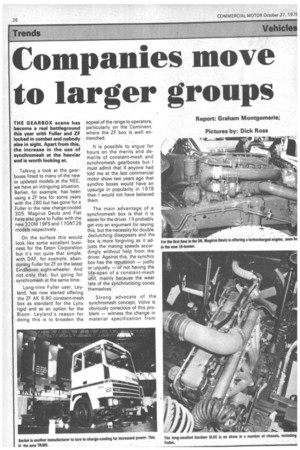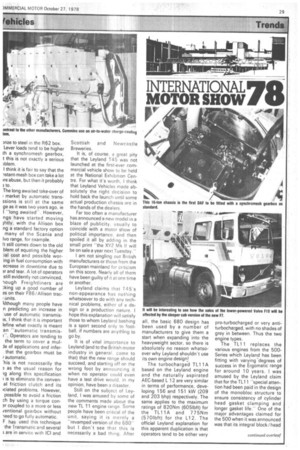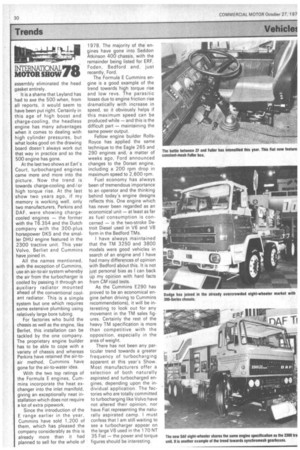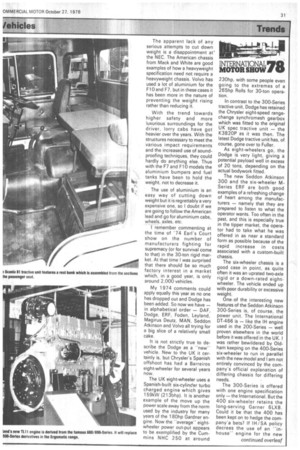Companies move to larger groups
Page 30

Page 31

Page 32

Page 33

Page 34

If you've noticed an error in this article please click here to report it so we can fix it.
Talking a look at the gearboxes fitted to many of the new or updated models at the NEC, we have an intriguing situation. Berliet, for example, has been using a ZF box for some years with the 280 but has gone for a Fuller in the new charge-cooled 305. Magirus Deutz and Fiat have also gone to Fuller with the new 320M 19FS and 170NT26 models respectively.
On the surface this would look like some excellent business for the Eaton Corporation but it's not quite that simple, with DAF, for example, abandoning Fuller for ZF on the latest Eindhoven eight-wheeler. And not only that, but going for synchromesh at the same time.
Long-time Fuller user, Leyland, has now started offering the ZF AK 6-90 constant-mesh box as standard for the Lynx rigid and as an option for the Bison. Leyland's reason for doing this is to broaden the appeal of the range to operators, particularly on the Continent, where the ZF box is well entrenched.
It is possible to argue for hours on the merits and demerits of constant-mesh and synchromesh gearboxes but I must admit that if anyone had told me at the last commercial motor show two years ago that synchro boxes would have an upsurge in popularity in 1 978 ,then I would not have believed them.
The main advantage of a synchromesh box is that it is easier for the driver. I'll probably get into an argument for saying this, but the necessity for double declutching disappears and the box is more forgiving as it adjusts the mating speeds accordingly without help from the driver. Against this, the synchro box has the reputation — justly or unjustly — of not having the life-span of a constant-mesh unit, mainly because the wear rate of the synchronising cones themselves.
Strong advocate of the synchromesh concept, Volvo is obviously conscious of this problem — witness the change in material specification from )nze to steel in the R62 box. Lever loads tend to be higher th a synchromesh gearbox, t this is not exactly a serious
I think it is fair to say that the "stant-rnesh box can take a lot we abuse, but then it probably 3 to.
The long awaited take-over of ! market by automatic transssions is still at the same ge as it was two years ago, ie I "long awaited". However,. ngs have started moving jhtly, with the Allison box ng a standard factory option many of the Scania and Ivo range, for example. It still comes down to the old blem of equating the higher :lel cost and possible woring in fuel consumption with ecrease in downtime due to 3r and tear. A lot of operators still evidently not convinced, lough Freightliners are king up a good number of as on their F86/Allison trac, units.
kithough many people have n predicting an increase in use of automatic transmisI think that it is important lefine what exactly is meant an "automatic transmis1". Operators are tending to the term to cover a mulJe of applications and inferthat the gearbox must be automatic,
his is not necessarily the D as the usual reason for ig along this specification is to eliminate the convenal friction clutch and its iciated problems. However, possible to avoid a friction ch by using a torque conar coupled to a more or less rentional gearbox without leed to go fully automatic. F has used this technique the Transrnatic and several 3 are in service with ICI and Scottish and Newcastle Breweries.
It is, of course, a great pity that the Leyland T45 was not launched at the first-ever commercial vehicle show to be held at the National Exhibition Centre. For what it's worth, I think that Leyland Vehicles made absolutely the right decision to hold back the launch until some actual production chassis are in the hands of the dealers.
Far too often a manufacturer has announced a new model in a blaze of publicity, usually to coincide with a motor show of political importance, and then spoiled it all by adding in the small print "the XYZ Mk II will be on sale a year next Tuesday."
I am not singling out British manufacturers or those from the European -mainland for criticism on this score. Nearly all of them have been guilty of it at one time or another.
Leyland claims that T45's non-appearance has nothing whatsoever to do with any technical problems, either of a design or a production nature. I hope this explanation will satisfy those to whom Leyland bashing is a sport second only to football, if numbers are anything to go by.
It is of vital importance to Leyland (and to the British motor industry in general, come to that) that the new range should succeed, and starting off on the wrong foot by announcing it when no operator could even have a test drive would, in my opinion, have been a disaster.
Still on the subject of Leyland, I was amused by some of the comments made about the new TL 1'1 engine range. Some people have been critical of the unit, saying it is merely a "revamped version of the 680" but I don't see that this is necessarily a bad thing. After
all, the basic 680 design has been used by a number of manufacturers to give them a start when expanding into the heavyweight sector, so there is absolutely no reason whatsoever why Leyland shouldn't use its own engine design!
The turbocharged TL11A based on the Leyland engine and the naturally aspirated AEC-based L 12 are very similar in terms of performance, developing 156 and 151 kW (209 and 203 bhp) respectively. The same applies to the maximum ratings of 820Nm (605Ibft) for the TL11 A and 775Nm (570Ibft) for the L12. The official Leyland explanation for this apparent duplication is that operatqrs tend to be either very pro-turbocharged or very antiturbocharged, with no shades of grey in between. Thus the two engine types.
The TL11 replaces the various engines from the 500Series which Leyland has been fitting with varying 'degrees of success in the Ergomatic range for around 10 years. I was amused by the Leyland claim that for the TL11 "special attention had been paid in the design of the monobloc structure to ensure consistency of cylinder head gasket clamping and longer gasket life." One of the major advantages claimed for the 500 when it was announced was that its integral block/head assembly eliminated the head gasket entirely.
It is a shame that Leyland has had to axe the 500 when, from all reports, it would seem to have been put right. Certainly in this age of high boost and charge-cooling, the headless engine has many advantages when it comes to dealing with high cylinder pressures, but what looks good on the drawing board doesn't always work out that way in practice and so the 500 engine has gone.
At the last two shows at Earl's Court, turbocharged engines came more and more into the picture. Now the trend is towards charge-cooling and/or high torque rise. At the last show two years ago, if my memory is working well, only two manufacturers, Perkins and DAF, were showing chargecooled engines — the former with the T6.354 and the Dutch company with the 300-plus horsepower DKS and the smal ler DHU engine featured in the 2300 tractive unit. This year Volvo, Berliet and Cummins have joined in.
All the names mentioned, with the exception of Cummins, use an air-to-air system whereby the air from the turbocharger is cooled by passing it through an auxiliary radiator mounted ahead of the conventional coolant radiator. This is a simple system but one which requires some extensive plumbing using relatively large bore tubing.
For factories who build the chassis as well as the engine, like Berliet, this installation can be tackled by the one company. The proprietary engine builder has to be able to cope with a variety of chassis and whereas Perkins have retained the air-toair method, Cummins have gone for the air-to-water idea.
With the two top ratings of the Formula E engines, Cum mins incorporate the heat exchanger into the inlet manifold, giving an exceptionally neat installation which does not require a lot of extra pipework.
Since the introduction of the E range earlier in the year, Cummins have sold 1,200 of them, which has pleased the company considerably as this is already more than it had planned to sell for the whole of 1978. The majority of the engines have gone into Seddon Atkinson 400 chassis, with the remainder being listed for ERF, Foden, Bedford and, just recently, Ford.
The Formula E Cummins engine is a good example of the trend towards high torque rise and low revs_ The parasitic losses due to engine friction rise dramatically with increase in speed, so it obviously helps if this maximum speed can be produced while — and this is the difficult part — maintaining the same power output.
Fellow engine builder RollsRoyce has applied the same technique to the Eagle 265 and 290 engines and, a matter of weeks ago, Ford announced changes to the Dorset engine, including a 200 rpm drop in maximum speed to 2,600 rpm.
Fuel economy has always been of tremendous importance to an operator and the thinking behind today's engine designs reflects this. One engine which has never been regarded as an economical unit — at least as far as fuel consumption is concerned — is the two-stroke Detroit Diesel used in V6 and V8 form in the Bedford TMs.
I have always maintained that the TM 3250 and 3800 models were good vehicles in search of an engine and I have had many differences of opinion with Bedford about this. It is not just personal bias as I can back up my opinion with hard facts from CM road tests.
As the Cummins E290 has proved to be an economical engine (when driving to Cummins recommendations), it will be interesting to look out for any movement in the TM sales figures. Certainly the rest of the heavy TM specification is more than competitive with the opposition, especially in the area of weight.
There has not been any particular trend towards a greater frequency of turbocharging apparent at this year's Show. Most manufacturers offer a selection of both naturally aspirated and turbocharged engines, depending upon the individual application. The factories who are totally committed to turbocharging like Volvo have not altered their opinion, nor have Fiat representing the naturally aspirated camp. I must confess that I am still waiting to see a turbocharger appear on the large V8 used in the 170 NT 35 Fiat — the power and torque figures should be interesting.
The apparent lack of any serious attempts to cut down weight is a disappointment at the NEC. The American chassis from Mack and White are good examples of how a heavyweight specification need not require a heavyweight chassis. Volvo has used a lot of aluminium for the F10 and F7, but in these cases it has been more in the nature of preventing the weight rising rather than reducing it.
With the trend towards higher safety and more luxurious surroundings for the driver, lorry cabs have got heavier over the years. With the structures necessary to meet the various impact requirements and the increased use of soundproofing techniques, they could hardly do anything else. Thus with the F7 and F10 models the aluminium bumpers and fuel tanks have been to hold the weight, not to decrease it.
The use of aluminium is an easy way of cutting down weight but it is regrettably a very expensive one, so I doubt if we are going to follow the American lead and go for aluminium cabs,, wheels, axles, etc.
I remember commenting at the time of '74 Earl's Court show on the number of manufacturers fighting for supremacy (or for survival come to that) in the 30-ton rigid market. At that time I was surprised that there should be so much factory interest in a market which, in a good year, is only around 2,000 vehicles.
My 1974 comments could apply equally this year as no one has dropped out and Dodge has been added. So now we have — in alphabetical order — DAF, Dodge, ERF, Foden, Leyland, Magirus Deutz, MAN, Seddon Atkinson and Volvo all trying for a big slice of a relatively small cake.
It is not strictly true to describe the Dodge as a ''new" vehicle. New to the UK it certainly is, but Chrysler's Spanish offshoot has had a Barreiros eight-wheeler for several years now.
The UK eight-wheeler uses a Spanish-built six-cylinder turbo charged engine which gives 159kW (213bhp). It is another example of the move up the power scale away from the norm used by the industry for many years of the 180hp Gardner engine. Now the "average" eight wheeler power out-put appears to be exemplified by the Cummins NHC 250 at around 230hp, with some people even going to the extremes of a 265hp Rolls for 30-ton operation.
In contrast to the 300-Series tractive unit, Dodge has retained the Chrysler eight-speed range change synchromesh gearbox which was fitted to the original UK spec tractive unit — the K3820P as it was then. The latest Dodge tractive unit has, of course, gone over to Fuller.
As eight-wheelers go, the Dodge is very light, giving a potential payload well in excess of 20 tons, depending on the actual bodywork fitted.
The new Seddon Atkinson 300 and the six-wheeler MSeries ERF are both good examples of a refreshing change of heart among the manufacturers — namely that they are prepared to listen to what the operator wants. Too often in the past, and this is especially true in the tipper market, the operator had to take what he was offered in as near a standard form as possible because of the rapid increase in costs associated with a custom-built chassis.
The six-wheeler chassis is a good case in point, as quite often it was an uprated two-axle rigid or a down-rated eightwheeler. The vehicle ended up with poor durability or excessive weight.
One of the interesting new features of the Seddon Atkinson 300-Series is, of course, the power unit. The International DT-466 is — like the IH engine used in the 200-Series — well proven elsewhere in the world before it was offered in the UK. I was rather bewildered by Oldham keeping on the 400-Series six-wheeler to run in parallel with the new model and I am not entirely convinced by the company's official explanation of differing chassis for differing needs.
The 300-Series is offered with one engine specification only — the International. But the 400 six-wheeler retains the long-serving Garner 6LXB.
Could it be that the 400 has been kept on to hedge the com pany'a bets? If IH / SA policy decrees the use of an "inhouse" engine for the new machine, what better way of retaining the old Gardner customers than by keeping the 400 on the stocks?
On the AiIse (sorry, Volvo Trucks (Great Britain) Ltd) stand, the new F7 is quite rightly attracting a great deal of interest. As far as this country is concerned, I am rather surprised that Volvo is not exhibiting an example of the "UK spec" tractive unit as well as the two models which make up the F7 display.
A large proportion of the total F86 production came to the UK with the light weight being a major selling point, especially with tractive unit. As I mentioned earlier, increased cab safety plus more sound deadening equals a heavier cab, with the result that the standard European F7 tractive unit came out a little heavier than the F86.
So for the UK market, away went the parabolic springs with their attendant anti-roll bars and away went the wider brake, drums pioneered by Irvine. With the short cab and the TD 70G engine, the UK F7 was thus back near the F86 in terms of weight.
The F-engined version of the F7 is well poised to carry on where the F86 left off and also, I feel, to pinch a few sales from ID 100C version of the big brother F10, especially in sleeper-cab form when the two are very evenly matched indeed specification-wise.
Not content with launching one new vehicle at the NEC, Magirus went the whole hog and launched five. All five should have been present but the bonnet dumper-based heavy haulage tractive unit could not be made ready in time.
Since Magirus started in the UK, the company has been expanding gradually in terms of market sectors as well as sales. The latest markets are for 16 and 24-ton rigids. Whereas the eight-wheeler Maggie was available originally with only one wheelbase (the option only
being announced at Birmingham) the 168M 16FL 16-tonner is immediately on the market with four wheel-bases ranging from 3.8 to 5.55mm (12ft 6in to 18ft 2in).
Unusual for a Magirus, it is fitted with a turbocharged engine — in fact the first Maggie so fitted in the UK. This is a six-cylinder version of the F4L 913 engine from the Fiatderived lightweight range. Although the power race in the maximum-capacity artics has now levelled off, there is still plenty of evidence that the trend is towards a higher power-toweight ratio in the lower weight ranges. The 16-ton Magirus illustrates the point, with nearly 170 horsepower giving well over 10bhp/ton — a characteristic it shares with such competitors as the Mercedes and Fiat 16-ton chassis.
Applying a rigid bhp/ton ruling gets rather meaningless anyway the further down the weight range you try to apply it. A 32-ton artic with a power-toweight ratio right on 6bhp/ton is still a feasible proposition for maintaining satisfactory progress over the road. If the same ratio were to be strictly applied to a 71/2-tonner or, even worse,. one of the lighter Transits, then an undriveable vehicle would result.
Magirus Deutz has always been a good example of sensible
rationalisation with, for example, the vee range of Deutz engines. This range is of modular construction sharing the same pistons, barrels, con rods and so on whatever the rating. Thus the V10 is basically the same engine as the V8 with an extra ''V-twin" tacked on. With the latest modified Deutz en
gines, the bore and stroke have both been increased by 5mm (0.197in) which has raised the capacity of each cylinder to 1.6 litres (98 cuin).
Although Bedford is exhibiting a chassis from the G MC range at the NEC — for the first time at a UK motor show — it should not necessarily be taken as a guide that Bedford is to sell the machine in this country. As with Frankfurt, GM treats the British motor show as a European rather than as a domestic showcase, with a large proportion of overseas visitors and well reported in the international press.
I hasten to add that this does not mean _ that the GMC Brigadier six-wheeler will never be sold here. I am sure if someone approached Bedford with an appropiate amount oI folding money, then the Brigadier would then be added to the range of tipper chassit available in the UK.
At the IVECO press con• ference in Paris a few weeks ago, Bruno Beccaria suggestec that co-operation between dif. ferent companies might be necessary at the design stage ir view of the crippling costs o. producing a new vehicle. The production of a new cab i! probably the best (or worst! example.
To a certain extent, IVECC has been carrying out this ide with its own member companie of UN1C, Fiat and Magiru: Deutz. The two new Magiru tractive units, the top-weigh 170 models from Fiat and th. new Magirus 16-tonner al share the same cab, as can b, seen on the stands of the con' panies concerned.
The Maggie six and eighi wheeled rigids still retain the ol. Ulm cab but presumably thi is just a matter of time as, if th joint IVECO cab is light enoug to be used for a 16-tonner, should be satisfactory for three-axle machine.
Looking round Birmingham I was tempted ti ask if Mr Beccaria was right an( if so, which of the companie exhibiting this year might hay announced formal design ties the time the next show COME round. Leyland and Renaa Scania and Volvo? Hino an Dennis? A fascinating thought
































































































































































